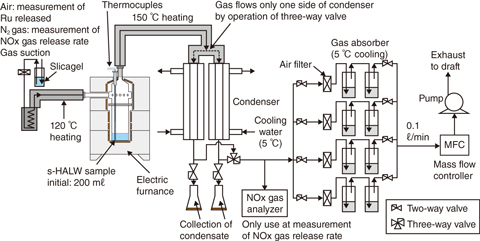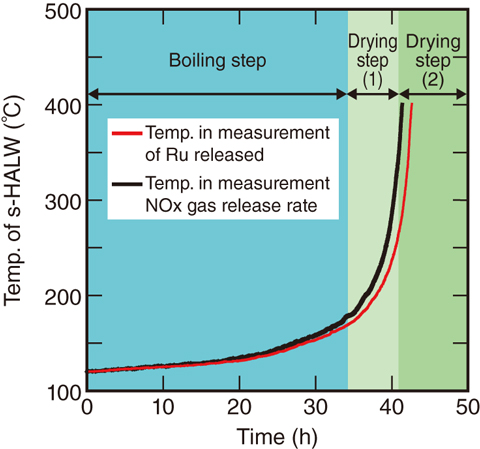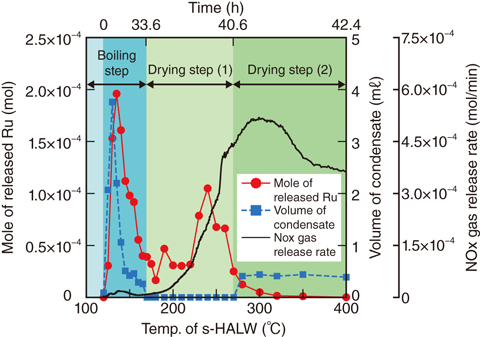
Fig.2-12 Diagram of the experimental apparatus

Fig.2-13 Condition of temperature increase of the s-HALW

Fig.2-14 Measurement results for mole of released Ru, volume of condensate, and NOx-gas release rate in terms of the s-HALW temperature
When the cooling function for HALW in the fuel-reprocessing plant is lost, the HALW is heated by the decay of dissolved radioactive materials, which may cause boiling and dryout. Since the radioactive materials may be released from the HALW to the air, it is necessary to quantitatively understand their release and transport behavior to evaluate the safety at a plant during such an accident. In particular, since Ruthenium (Ru) can transform into volatile species during the boiling and drying steps, the release ratio of Ru from the HALW would be larger than those of other non-volatile elements. Therefore, Ru is considered an important element from the viewpoint of estimating the public dose from the accident.
Therefore, we performed experiments to acquire practical data on Ru-release behavior using s-HALW, which was prepared with stable isotopes including lanthanide elements based on the composition of HALW. The test conditions included a very slow rate and time of temperature increase based on the computer code analysis for an HALW-storage tank in a postulated accident.
The s-HALW was heated in the electrical furnace shown in Fig.2-12 under the experimental condition of s-HALW-temperature rise, as shown in Fig.2-13. Measurement results for the mole of released Ru, the volume of condensate, and the NOx-gas-release rate in terms of the s-HALW temperature are shown in Fig.2-14. It was found that the release behavior of Ru was dependent upon three divided zones of the s-HALW temperature during the period from the boiling step to the drying step.
The release mechanism of Ru in each region was considered as follows. In the boiling step, the concentration of s-HALW increased owing to steam release. Ru was released as a volatile species transformed by the oxidizability of highly concentrated nitric acid. When the release of steam went to the end, the amount of the Ru release was temporarily decreased. In the drying step (1), in which the condensate was not collected, Ru release resulted from progress of thermal decomposition of Ru nitrate with NOx release in the dried s-HALW. In the drying step (2), a small amount of steam was released, probably owing to desorption of hydrates of lanthanide nitrates. The NOx release was owing to thermal decomposition of lanthanide nitrates. In contrast, the amount of Ru released monotonically decreased because of the regress of thermal decomposition of Ru nitrate in the drying step (1). We are the first group to obtain detailed data on the amount of Ru released depending on the HALW temperature during the drying-step period. These data will be useful for investigating effective accident-management measures to mitigate the amount of the Ru release, considering the HALW temperature if the accident is in the drying step owing to loss of the cooling function.